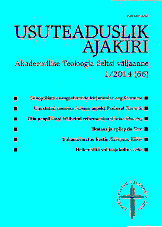Miks ebaõnnestus Riia peapiiskopi Wilhelmi 1540. aastatel ettevõetud reformatsioonikatse?
Why Was the Attempt of Archbishop Wilhelm to Introduce the Reformation in the 1540s a Failure?
Author(s): Madis MaasingSubject(s): Christian Theology and Religion
Published by: Akadeemiline Teoloogia Selts
Keywords: Church History; Reformation in Livonia
Summary/Abstract: Although after introduction of the Reformation in the 1520s the new faith spread extensively all over Livonia, the Protestant Church Order was not formally enforced outside the city walls before the 1560s. In older literature, it is often assumed that the reason lies in the fact that ecclesiastic rulers of Livonia remained Catholic. But Paul Karge claimed already in the 1920s that they opposed the formal introduction of the new faith – proposed by Lutheran Archbishop Wilhelm of Riga in the 1540s – not because of religious reasons, but out of fear that it could lead to secularization of Livonia. In great part, Archbishop Wilhelm’s attempt to enforce the Reformation was connected to his goal to strengthen his political position in conflict with the Teutonic Order in Livonia. But when a compromise was reached between him and the Order in 1546, political reason for the Reformation disappeared. Moreover, Wilhelm leaned on his brother Albrecht, Duke of Prussia, who had secularized Prussia in 1525, and who therefore was seen as a danger by the Order and Livonian bishops. In conclusion, the latter had no reasons to support any of the Archbishop’s plans that could have been strengthened the positions of Prussian faction in Livonia, even if it could not directly lead to the secularization of Livonia.
Journal: Usuteaduslik Ajakiri
- Issue Year: 2014
- Issue No: 1 (66)
- Page Range: 45-61
- Page Count: 17
- Language: Estonian

